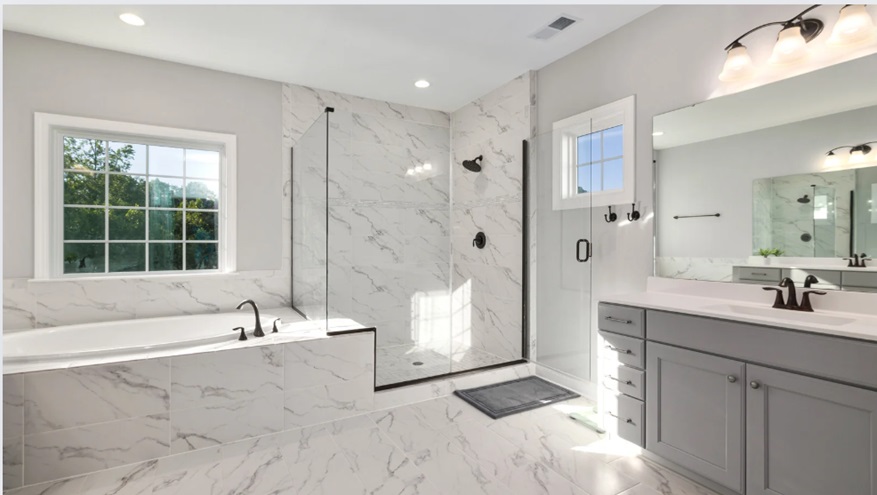Proper ventilation should be noticed when creating comfortable and functional living spaces, especially in bathrooms. However, for homeowners in Cumming and beyond, understanding the importance of bathroom ventilation is crucial for maintaining a healthy and pleasant home environment. Bathrooms in Cumming require special attention to ventilation due to the unique challenges posed by moisture, humidity, and odors. This comprehensive guide will explore the ins and outs of bathroom ventilation, helping you make informed decisions for your home improvement projects.
The Importance of Bathroom Ventilation:
Bathrooms are hotspots for moisture accumulation, making them prime breeding grounds for mold, mildew, and bacteria. Proper ventilation removes excess moisture, prevents structural damage, and maintains good indoor air quality. Without adequate ventilation, bathrooms can become damp, musty, and potentially hazardous to your health.
Effective ventilation systems help regulate humidity levels, reduce surface condensation, and eliminate unpleasant odors. They also play a crucial role in preserving the integrity of your bathroom’s fixtures, finishes, and building materials. By investing in proper ventilation, you’re not only enhancing comfort but also protecting your home’s value and longevity.
Types of Bathroom Ventilation Systems:
There are several options available for bathroom ventilation, each with its own set of advantages and considerations:
- Exhaust Fans: Exhaust fans are the most common and cost-effective solution for bathroom ventilation. They work by drawing moist air and odors out of the bathroom and expelling them outside. When selecting an exhaust fan, please take into account key aspects like its airflow capacity, indicated in cubic feet per minute (CFM), the noise level it generates, and its energy efficiency.
- Window Ventilation: Natural ventilation through windows can effectively supplement mechanical systems. However, it’s important to note that relying solely on windows may not provide sufficient air exchange, especially in humid climates or during colder months.
- Whole-House Ventilation Systems: For a more comprehensive approach, whole-house ventilation systems can be integrated into your home’s HVAC setup. These systems provide continuous air exchange throughout the entire house, including bathrooms, ensuring a constant supply of fresh air.
- Heat Recovery Ventilators (HRVs) and Energy Recovery Ventilators (ERVs): These advanced systems not only remove stale air but also recover heat or energy from the outgoing air to pre-condition incoming fresh air. While more expensive upfront, they can significantly improve energy efficiency and indoor air quality.
Sizing and Placement Considerations:
Proper sizing and placement of ventilation systems are crucial for optimal performance. The size of your bathroom, its layout, and the local climate all influence the appropriate ventilation solution.
Generally, bathroom exhaust fans should have a minimum airflow capacity of 1 CFM per square foot of bathroom area. For bathrooms larger than 100 square feet, add 50 CFM for each toilet, shower, or bathtub.
Placement is equally important. Exhaust fans should be installed near the shower or bathtub, where moisture is most concentrated. Multiple fans or a centralized system with multiple intake points may be necessary for larger bathrooms to ensure comprehensive coverage.
Bathroom renovation projects often require permits, including ventilation system installations or modifications. It’s essential to consult with local building authorities to ensure compliance with codes and regulations.
Maintenance and Upkeep:
Regular maintenance is key to keeping your bathroom ventilation system functioning efficiently. Here are some tips to keep in mind:
- Clean fan covers and grilles regularly to remove dust and debris.
- Inspect and clean exhaust ducts annually to prevent blockages.
- Check and replace fan motors as needed, typically every 10-15 years.
- Ensure that exterior vents are clear of obstructions and properly sealed.
- Test your ventilation system periodically to ensure it’s operating at peak performance.
Innovations in Bathroom Ventilation:
The field of bathroom ventilation continues to evolve, with new technologies emerging to improve efficiency and user experience. Some notable innovations include:
- Smart Ventilation Systems: These systems use sensors to detect humidity levels and automatically adjust fan speed accordingly. Some can even be controlled via smartphone apps, allowing for remote operation and monitoring.
- Ultra-Quiet Fans: Advancements in fan design have led to the development of whisper-quiet models that operate at noise levels as low as 0.3 sones, making them barely audible.
- Dual-Function Fixtures: Combination light/fan units and fan/heater combos offer space-saving solutions without compromising functionality.
- Designer Grilles: Aesthetically pleasing grille designs allow ventilation systems to blend seamlessly with bathroom decor, addressing concerns about visual appeal.
Conclusion:
Proper bathroom ventilation is a critical component of a healthy, comfortable home. By understanding the various options available and considering factors such as sizing, placement, and maintenance, homeowners can make informed decisions to optimize their bathroom environments. Whether planning a complete bathroom remodel or simply upgrading your existing ventilation system, investing in effective moisture control will pay dividends in air quality, structural integrity, and overall home comfort.










